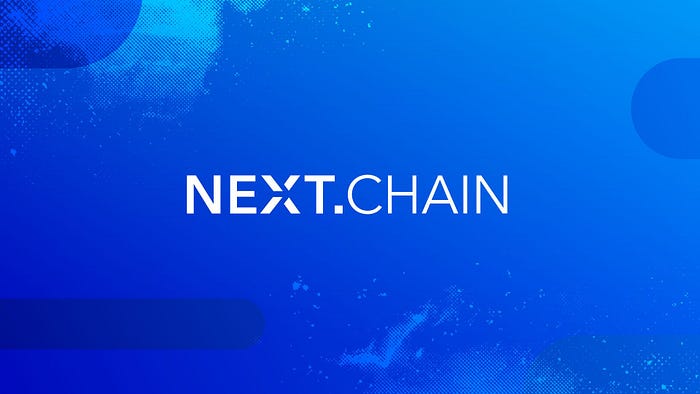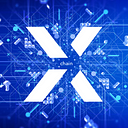NEXT.chain Insights.
Discover how NEXT.chain came to be, it’s functionality, some technical, and other interesting information.

Genesis Block: April 17, 2019.
NEXT.chain Blockchain explorer.
NEXT.chain Functionality
NEXT.chain was born on April 17, 2019 and is blockchain where which is build on the original Bitcoin-core protocol, add the tokenization and smart-contract features from Ethereum and put Master nodes with seniority bonuses (as seen within Dash), with the goal of providing a unique and powerful blockchain which can handle instant transactions with lightning speeds, that can power the complete NEXT ecosystem. Thus NEXT.chain is a hybrid blockchain with combined security and efficiency aspects of POW (Proof-Of-Work) and POS (Proof-Of-Stake).
Why did we need a blockchain of our own?
Many currently active blockchains within the industry are unfortunately incapable of facilitating transaction throughput that can accommodate the needs of a mass and growing market. Nowadays we prove that we are right. The success of decentralized applications like Uniswap and the bull-run is making transaction fees as high as $50,-. Even presales are have troubles to get every investor onboard, unless they pay massive gasprices. And with a further raise we expect even higher prices. That is not sustainable at all and therefore we created our own blockchain, where we define a maximum supply of 30,3M and fixed transactions fees where we integrate layer-2 technologies directly on the chain with the ability to create tokens (like ERC20). Exactly what the DeFi market is waiting for.
Throughput challenges
Legacy systems such as Visa are capable of processing 1,736 transactions per second while Bitcoin TPS hovers around 4.6. To reach the TPS of Visa, Bitcoin is required to scale its TPS by over 300 times. With Ethereum, the throughput challenge is a hard-coded limit on per block computation which limits TPS to roughly 17 per second. However, the power of the Ethereum network is set to increase with ETH 2.0. But even than we are not sure it will be enough to meet the demand, it’s even not sure when it will be launched, while we are now in the bull season. That is our advantage, we are already there to introduce NEXT.chain to the world.
Scalability Issues and Transaction Price Eruption
We noticed that during our development path that the Bitcoin and Ethereum blockchain was incapable of handling a massive and sporadic transaction influx. During the CryptoKitties hype phase, Ethereum saw almost 30,000 queued transactions to be processed. Almost 15% of the Ethereum network was occupied by the CryptoKitties Smart Contract. Nowadays, Uniswap has taken over this position. It’s a fact that Ethereums performance dropped significantly while processing the execution of these smart contracts. A single Ethereum transaction when a low gasfee can be queued for 20–30 minutes, transactions would frequently result in failures and subsequently require to be resubmitted, while the costs of doing this transactions are gone
NEXT.chain don’t have this issue. The transaction fee’s are always fixed and during the existence we never had even one single failure.
Advanced DAG Technology
In order to enable the ecosystem with high capacity and efficiency, NEXT.chain includes Instant Transaction Confirmations (ITC), which is an advancement of DAG technology (aka zk-snarks) so that transactions and digital assets can be transacted in real-time. DAG is known because of projects like Fantom or IOTA.
A hybrid consensus mechanism
NEXT.chain is a hybrid blockchain because it combines a Proof of Work (PoW) consensus algorithm with a Proof of Stake (PoS) algorithm. These multiple consensus layers create a blockchain which is extremely fast, private if chosen, all while being highly secure and ruling out the 51% vulnerability.
As the core layer, PoW carves all data into stone. The PoW is the strongest layer and makes NEXT extremely robust by using the SHA256D algorithm. Once mined, the transaction cannot be undone or changed. The miners receive packages of data that are bundled by the Masternodes or the Proof of Stake (PoS) layer of the blockchain.
This is the second layer, which makes private and instant transactions possible. Once a transaction is sent to the network, Master nodes are the first point of contact, and they make it possible for verification to happen while the block is technically still unmined. This technology of instant transactions is inspired by Directed Acyclic Graph or DAG-technology and runs on top of the Master node. NEXT.chain is home to the latest technology, leaving behind older blockchains which are often slow, expensive, and easily congested.
NEXT.chain Masternodes
Masternodes are the PoS layer of the NEXT.chain. Primary requirements to operate a NEXT Masternode include 25,000 NEXT (to be used as collateral, which cannot be spent once unlocked, though once collateral is unlocked for an extended period of time, seniority bonuses are lost), a server with 24/7 uptime. NEXT.chain masternodes are responsible for upholding transactional privacy, executing instant transactions, and upholding the decentralized network of NEXT.chain.
In general, transaction speeds are one of the most prominent features offered by any state-of-the-art blockchain. (Retail) users have grown accustomed to fast transactions. NEXT.chain, the core foundation of the NEXT ecosystem, ensures instantaneous transactions between users and peers. With the power of the NEXT.chain Masternode consensus and transaction locking combined, anyone can transfer NEXT coins seamlessly, securely, instantly.
Transaction locking is a feature that prevents double spending on Next.chain. Current systems (for example, Bitcoin and Ethereum) use block confirmation as an assurance against the double spend. The problem with block confirmations is that it takes a while for a given transaction to be confirmed. Transaction locking exists to improve upon block confirmation and to significantly speed up transactions on the NEXT.chain.
Masternodes are selected algorithmically to receive a transaction locking message, after which they vote on the validity of the transaction lock. If the selected Masternodes do not reach consensus then the transaction will resort to a standard confirmation for the assertion of transaction validity.
Masternodes are utilized as observers and are given greater authority in regard to InstantSend transactions, and by doing this, double spend protection can be guaranteed whilst ensuring low transaction times. Using Masternodes as such contrasts to how merchants currently obviate double spends in other cryptocurrency systems; where clients observe a network and signal to the merchant if any double spending attacks are identified.
Seniority
As a seniority benefit, Masternode operators receive a bonus to their base reward every 4 months that adds up to a 27% bonus after 3 years. This benefit is paid only if the collateral for an active Masternode is kept locked at the same address for the entire qualification period.
Super Block
Provide a payout from funded budget proposals that are approved by Masternodes by means of a governance system. These Super Blocks will be issued on a monthly basis with a coinbase which can be larger than average. There are 10% block rewards that are set aside for Super Block payouts.
